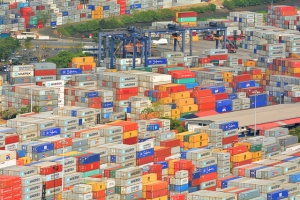

Photo of shipping containers at the Panama Canal by Sarah Murray licensed under CC BY 2.0
In October 2006, an historic decision was made – the 50-mile-long Panama Canal would be deepened and expanded to allow for the largest ships to pass through its channels. The estimated price tag of more than $4 billion was not a deal-killer and work was started on one of the largest, far-reaching projects in recent history.
Now, after a decade of work, the Panama Canal is set to open in early 2016. The far-reaching impact has touched numerous other countries, as Panama now offers a challenge for even the largest ports in the U.S. and Eastern Asia. The renovated Panama Canal will create tremendous competition, and shipping channels that can accommodate the larger vessels will receive huge benefits from increased shipping and trade.
Many port authorities located throughout the U.S. are pursuing projects to deepen harbors and construct larger terminals. Cost estimates for work that is needed related to port improvements is $46 billion. That amount includes both public- and private-sector ports.
About 20 percent of the United States’ port tonnage travels through ports located in Texas. And three ports in particular – Corpus Christi, Houston and Beaumont – rank among the 10 most utilized ports in the country. Since 2010, Texas has financed more than $300 million in port improvement, but that is far from what will be required. Other states have spent much more on improvements.
The Port Authority of New York and New Jersey is working on a project to raise the arch-style Bayonne Bridge connecting Bayonne, N.J., to Staten Island, N.Y. The structure will be raised from 151 feet to 215 feet above the water to allow for 64 feet of added air draft beneath the bridge to accommodate larger ships. These improvements are expected to cost around $6 billion and the work will be completed in 2016.
PortMiami in Florida recently completed a $1 billion project. Now, new and larger cranes will be able to service greater amounts of freight from cargo ships. The project also included a new rail service partnership between the port and Florida East Coast Railway (FECR) that will link the port to the mainland, and the main port harbor was dredged to deepen the channel.
The Port of Mobile, Ala., has completed enhancements to allow greater container capacity. New cranes and a new steel handling facility were added. The Port of Long Beach, Calif., has consolidated two older shipping terminals and developed a 304-acre environmentally conscious and technologically progressive “mega–terminal.” After all renovations are completed in 2019, the port will have doubled the capacity of the two terminals, and the new level of cargo passing through the port will support more than 14,000 new jobs in the region.
Ports globally are expanding and implementing new strategies. Global competition has been, and will continue to be, the driver. The costs are extremely high, but the return on investment (ROI) will be huge. Jobs are created, opportunities abound, trade increases and the economy is stimulated throughout the country. The results are all good!
SPI’s team of procurement experts will help you take advantage of contracting opportunities created by government investment like the Panama Canal expansion. Contact them now!
